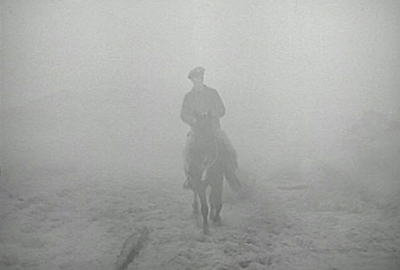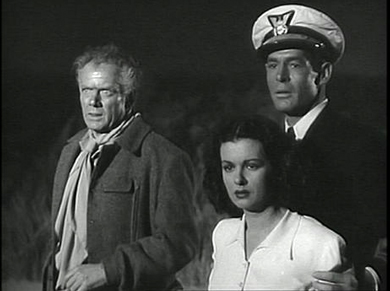
 |
|
|
|
French director Jean Renoir spent World War II in Hollywood, as did numerous other European film stars and directors. Some German refugee directors and writers had emigrated earlier in the 1930s and were firmly established, but Renoir and Max Ophüls chose to return to their home countries a few years after the Allied victory. Renoir made some interesting pictures here, the best-known being This Land is Mine, a patriotic morale booster that gave Charles Laughton one of his best acting showcases. 1947's Woman on the Beach has garnered its share of critical praise over the years, especially when it became a hard-to-see item. It's usually listed as a film noir by default, what with actors Joan Bennett and Robert Ryan topping the cast list. Dark, moody and somewhat pessimistic about relationships, the film resists falling into any particular genre. Assigned to a mounted beach patrol outfit still operating months after the finish of the war, Coast Guard officer Scott (Robert Ryan) is haunted by a dream of drowning in a shipwreck and meeting a beautiful female sea-ghost in the murky depths. Scott is engaged to local boat builder Eve (Nan Leslie) but behaves erratically toward her; they plan to marry as soon as he's mustered out in a couple of weeks. Scott then meets the dark, moody Peggy (Joan Bennett), who lives in a lonely house with her older husband Tod (Charles Bickford), a famous painter whose career was halted by blindness. Peggy and Tod were once high-living socialites, and she resents their enforced isolation. Todd refuses to sell his priceless inventory of paintings, claiming that they are all that remains of his previous artistic fame. Although sightless, Tod senses immediately that Scott is attracted to Peggy and perversely encourages his visits. Scott neglects Eve and fixates on proving that the insinuating, somewhat manipulative Tod isn't really blind. He takes the man on a walk next to the beach cliffs, and borrows a boat on a stormy day so that they can go fishing. Seeing Scott on the sly, Peggy quietly goes along with his unbalanced, potentially homicidal behavior. Then Scott learns about another local man who came to a bad end after befriending Peggy and Tod. 
Woman on the Beach was originally to be produced by RKO's noted Val Lewton, as his promotion from B-unit horror films to the studio's A-list productions. Lewton and director Renoir worked out the story and casting but the production was repeatedly delayed. Lewton had to bow out when he suffered his first stress-related heart attack; the show went before the cameras a couple of months later. Writer Joel E. Siegel reported that the movie was eventually taken away from Renoir, and "extensively re-edited and re-shot." The 'dreamlike, elliptical' feeling imparted by short scenes that fade at odd moments may well be the result of Jack Gross truncating longer original scenes. It's not surprising that this is Jean Renoir's last Hollywood film. Even so, Val Lewton's fingerprints are all over the finished film. Eve builds boats, a favored profession in Lewton stories. Peggy was once a carefree playgirl in the New York art world, a 'sensationalist' similar to the mysterious Jacqueline Gibson in Lewton's The Seventh Victim. Scott's sinking ship nightmare is partly rendered in animation like the phantoms in the hypnosis scenes in Cat People, and takes the place of the horror curses from Lewton's previous output. As everything in Scott's drowning dream aligns with reality, perhaps the other local man unlucky to meet Peggy and Tod is represented as well -- by the skeleton that the drowned Scott walks over as he embraces his glowing woman on the bottom of the sea. The key to the characters is ambiguity. A likeable and inoffensive hero, Scott seems to be mentally ill: he's given the rather blunt dialogue line, "I'm not well." Scott is tender with Peggy, cruel in his dealings with Eve, and utterly psychotic toward Tod. Refusing to believe that the artist is blind, Tod literally walks him off a cliff; when the older man comes out of that with hardly a scratch, Scott takes him on a boat ride guaranteed to end in disaster. It's all part of Scott's death wish, part of his vision of a beautiful death at the bottom of the sea. Peggy is ambivalent as well. She plays the wounded bird, trapped and begging to be set free by the handsome Scott. Romantically speaking she's an irresistible lure. But Peggy is also a shameless liar who deceives Tod at every turn. She hides one of his paintings, perhaps hoping to secretly sell it. The revelation that Peggy, like a siren, has lured other servicemen onto the rocks should make her as unpleasant a villainess as Phyllis Diedrichson in Double Indemnity. Yet Woman on the Beach wants us to accept Peggy as a merely troubled woman going through emotional problems. 
Tod seems a sick puppy from the moment he encourages the equally disturbed Scott to frequent his beach cabin. Scott foolishly thinks that Tod can see, when the old artist really "sees" through the little romance Scott and Peggy are trying to hide. It's a perverse little game rather similar to the ugly "take my wife -- please" story idea behind Roman Polanski's later Bitter Moon. It is easy to imagine the cultured Lewton and the brilliant Renoir forming a powerful creative combination, fashioning a complex, moody and ambiguous psychodrama. Lewton's most interesting film The Seventh Victim attempted to ignore genre blueprints, and concentrated instead on half-explained characters with murky motivations. The released version of Woman on the Beach tries to keep its characters a mystery and explain them too, which leads to a fairly unsatisfactory finish for viewers primed for melodramatic intrigues. Woman on the Beach is far more satisfying as a physical production. The Coast Guard station and the little community around it are neatly sketched, showing Scott as an outsider in his own command. He looks noble yet obsolete patrolling the empty beaches on horseback. The animated dream sequences use dated visuals, yet communicate clearly Scott's death wish. 1 Peggy, the "Siren on the Beach", makes love with Scott in a beached, rotting ship's hull, Scott's dream transposed to dry land. When they peer out through a porthole at the approaching Tod, it's as if the blind man were intruding on their emotional fantasy. But whether the story is flawed or the forced re-shoots garbled the message, Woman on the Beach doesn't resolve itself in an acceptable manner. The last scene purports to give the characters a catharsis that we don't really feel -- all three protagonists are too twisted to be straightened out so easily, and Peggy's final decision seems as inconsistent as Scott's sudden fearlessness in a sinking boat. We respect the filmmaking talent behind this unusual picture and realize that it was pushed out of shape by an interfering studio. But we understand why it wasn't a big hit. 
Charles Bickford and Joan Bennett do well with their difficult roles, although each seems to be missing a vital scene that would either clarify their motivations or make them more consistent. This is one movie where Bennett never gets a chance to weave her glamorous spell -- she's most often seen dressed in thick sweaters and a windbreaker. Sad as it is to say it, Robert Ryan suffers the most. His Scott is too soft when he's vulnerable and a reckless fool when determined to expose Tod as a faker. It's hard to believe that Robert Ryan would show the stress of combat in quite this way, and the story charts a lot of willfully malicious decisions that are his fault alone. As soon as he mistreats poor Eve, we stop liking him anyway. When (spoiler) everyone is "liberated" in the last scene, we can't believe that Scott has been cured of anything. From the viewpoint of studio politics, Woman on the Beach was just one of many half-stalled projects probably designed to frustrate producer Lewton into leaving RKO. Renoir was apparently allowed to film the movie in an avant-garde fashion, and then compelled to re-shape it as a more conventional commercial item. Renoir and especially Ophüls made fine pictures in Hollywood; it would be interesting to find out if Woman on the Beach is really a damaged remnant of what might have been a masterpiece. 
The Warner Archive Collection DVD-R of Woman on the Beach is a Remastered Edition that does a wonderful clean-up job on a picture that saw very little exhibition in proportion to its mentions in classic-era film criticism - it was praised as sophisticated and subtle by critics eager to shape every auteur director's career into a consistent artistic progression. The new transfer billboards the work of Renoir's two cinematographers Leo Tover and Harry J. Wild, one of whom was probably the re-shoot DP. It provides an even better showcase for the music of composer Hans Eisler, one of the early 'persons of interest' to the HUAC who was soon deported for his German Communist background.
On a scale of Excellent, Good, Fair, and Poor,
Woman on the Beach rates:
Footnotes: 1. The unusually downbeat 'comedy' Mr. Peabody and the Mermaid uses the same morbid theme. Ann Blyth's mermaid represents the ultimate escape from reality, an obsession that becomes so strong for Mr. Peabody that it can't be distinguished from a death wish. Peabody chooses a rhapsodic exit from life as he knows it, or, to be blunt, death. Isn't that what the myth of sirens is all about?
The same goes for Close Encounters of the Third Kind, when Neary steps cheerfully into the mothership. He's voluntarily departing this planet for a new destination 'somewhere out there'.
Reviews on the Savant main site have additional credits information and are often updated and annotated with reader input and graphics. Also, don't forget the 2010 Savant Wish List. T'was Ever Thus.
Review Staff | About DVD Talk | Newsletter Subscribe | Join DVD Talk Forum |
| ||||||||||||||||||